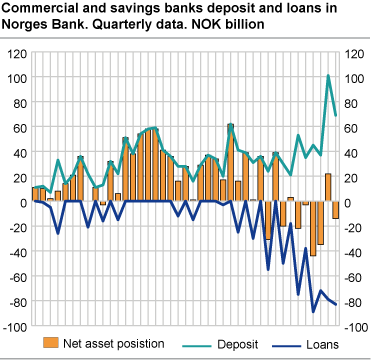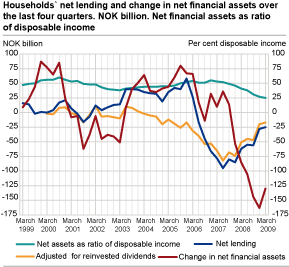Content
Published:
This is an archived release.
Households consolidate their position
Households and non-profit institutions serving households strengthened their financial position in the first quarter of 2009, inter alia through reduced borrowing. Net lending in general government, on the other hand, declined significantly due to lower revenues from oil and gas activities.
Households’ net lending was NOK -25 billion in the last four quarter period, which is NOK 3 billion higher than in the previous period to the fourth quarter of 2008. Holding losses amounted to NOK 105 billion, and combined with negative net lending this contributed to a reduction in net financial assets of NOK 130 billion in the last four quarter period.
Increased saving and fall in investments in the first quarter of 2009
Borrowing declined significantly in the last quarter compared with the same quarter in 2008. At the same time, investments in financial assets fell. The development in bank deposits was particularly modest, while the acquisition of quoted securities and mutual fund shares recovered in the last quarter. The total picture indicates that many households are consolidating their financial position. The development in the financial accounts is consistent with the movement in the non-financial accounts in the first quarter of 2009, where households increased their savings, while the fixed capital formation declined.
Loans exceed deposits in the Central Bank
Due to the financial turmoil, the Central Bank has supplied the commercial and savings banks with liquid means beyond standard, inter alia by lending (F-loans). At the end of the first quarter of 2009, domestic banks were in a net lending position to the Central Bank. Deposits amounted to NOK 69 billion, while loans amounted to NOK 83 billion. Under normal conditions, banks have higher deposits than loans in the Central Bank.
Central government’s net lending declined
The central government’s net lending in the four quarters up to first quarter of 2009 is calculated to NOK 409 billion, which is down NOK 103 billion from the previous period to the fourth quarter of 2008. The development is explained by falling investments in the Government Pension Fund- Global due to lower revenues from oil and gas activities at the end of the last four quarter period. The quoted development in securities and currency exchange rate developments contributed to a net holding loss of NOK 543 billion and a reduction in central government’s net financial assets of NOK 134 billion during the four quarter period.
Increase in securities debt in local government
The local government’s net lending over the last four quarter period was NOK1-30 billion compared with NOK1-29 billion in the period to the fourth quarter of 2008. This development reflects, among other factors, high and increasing growth in municipal consumption expenditures. The local government has in the last four quarter period increased its borrowing by NOK17 billion, which is mainly explained by an increase in bonds debt. The local government has also increased its lending to municipal corporations in the last four quarter period.
Net financial assets abroad declined in the first quarter of 2009
Norway’s net foreign assets were calculated to NOK 1 469 billion at the end of the first quarter of 2009. This is down by NOK 155 billion from the end of the fourth quarter of 2008, when net foreign assets were calculated at NOK 1 624 billion. In the last quarter, Norway’s net lending abroad was NOK 75 billion. Strengthening of the Norwegian krone contributed negatively to the NOK value of net foreign assets. The net effect in the first quarter of 2009 was net holding losses of NOK 230 billion.
| 1 | Corrected 7 August 2009. |
| 1. quarter 2007 | 2. quarter 2007 | 3. quarter 2007 | 4. quarter 2007 | 1. quarter 2008 | 2. quarter 2008 | 3. quarter 2008 | 4. quarter 2008 | 1. quarter 2009 | |||||||||||||||||||||||||||||||
|---|---|---|---|---|---|---|---|---|---|---|---|---|---|---|---|---|---|---|---|---|---|---|---|---|---|---|---|---|---|---|---|---|---|---|---|---|---|---|---|
| Financial assets | 5 280.1 | 5 367.8 | 5 369.3 | 5 531.6 | 5 395.4 | 5 500.7 | 5 829.2 | 6 477.5 | 5 946.8 | ||||||||||||||||||||||||||||||
| Liabillities | 3 998.2 | 4 072.2 | 4 117.0 | 4 277.3 | 4 143.5 | 4 275.8 | 4 374.3 | 4 853.1 | 4 477.3 | ||||||||||||||||||||||||||||||
| Net financial assets / net financial wealth | 1 281.9 | 1 295.6 | 1 252.4 | 1 254.2 | 1 251.9 | 1 224.9 | 1 454.9 | 1 624.4 | 1 469.5 | ||||||||||||||||||||||||||||||
| Change in net financial assets / net financial wealth | 6.8 | 13.7 | -43.2 | 1.9 | -2.4 | -27.0 | 230.1 | 169.5 | -154.9 | ||||||||||||||||||||||||||||||
| Other changes | -75.5 | -53.4 | -138.0 | -115.4 | -106.7 | -152.2 | 108.2 | 25.6 | -230.1 | ||||||||||||||||||||||||||||||
| Net lending | 82.3 | 67.0 | 94.8 | 117.3 | 104.3 | 125.1 | 121.9 | 143.9 | 75.2 | ||||||||||||||||||||||||||||||
DefinitionsNet lending as defined in non - financial accounts ( capital account ) = savings + net capital transfers - net acquisition of non - financial assets Net lending as defined in financial accounts = net acquisition of financial assets - net incurrence of liabilities Savings is non-consumed income and can be invested in financial or non-financial assets. If savings exceed non-financial investments, a sector has a surplus of funds and becomes a net lender to other sectors. In the financial transaction account, this means that the sector acquires more financial assets than liabilities. On the other hand, if savings are less than non-financial investments, investments have to be funded either by selling financial assets or incurring debts. Household investments in non-financial assets mainly reflect the purchase of new housing and fixed investments by unincorporated enterprises. They typically finance substantial parts of these investments by incurring debt in the form of loans. Net financial assets ( net financial wealth ) = total financial assets - total liabilities The financial balance sheet shows the financial position of a sector at the end of the reference period and is broken down into the categories of financial assets and liabilities. Insurance technical reserves, currency and deposits are the predominant assets held by households, while loans provided by financial corporations (banks etc.) constitute the main proportion of liabilities. Changes in net financial assets = net lending + other changes in assets , net The change in the financial balance sheet during the reference period is a result of accumulated financial transactions and other changes in assets. The latter category mainly reflects revaluations due to changes in market prices of financial instruments. |
Contact
-
Torbjørn Cock Rønning
E-mail: torbjorn.cock.ronning@ssb.no
tel.: (+47) 97 75 28 57
-
Jon Ivar Røstadsand
E-mail: jon-ivar.rostadsand@ssb.no
tel.: (+47) 21 09 43 69
-
Marit Eline Sand
E-mail: marit.sand@ssb.no
tel.: (+47) 40 90 26 74


